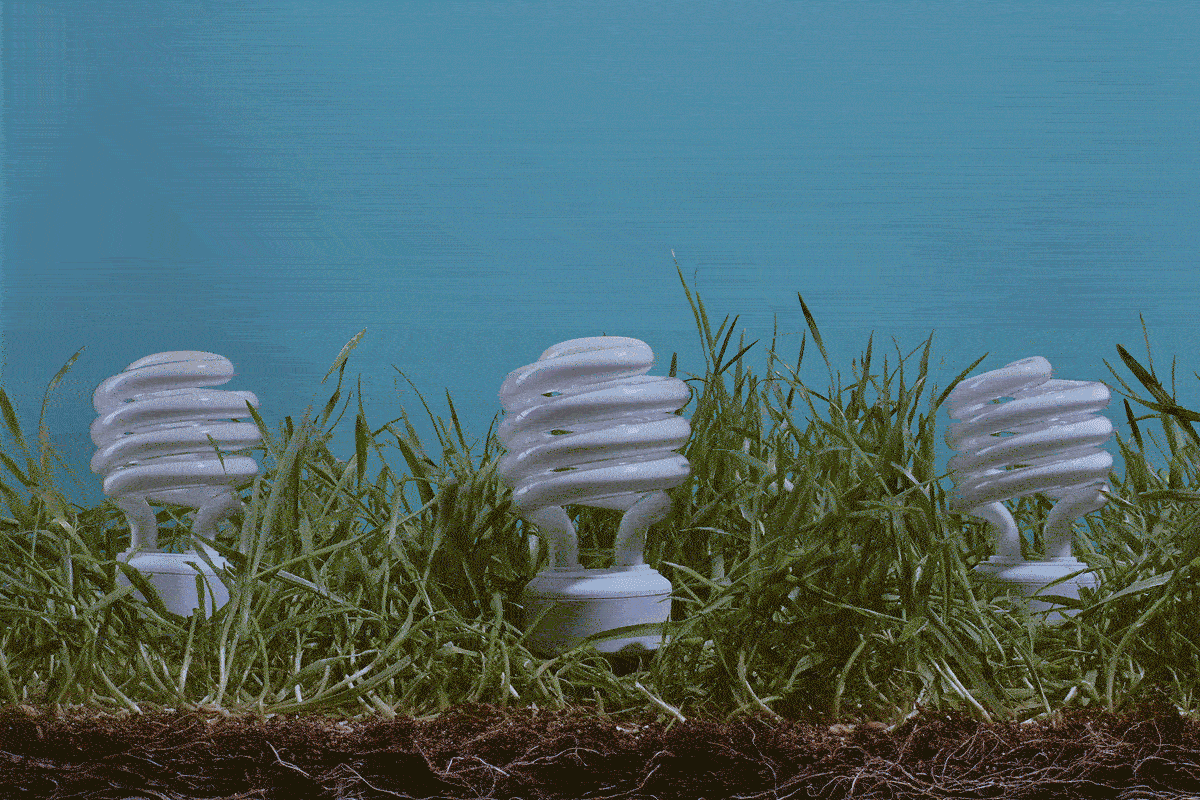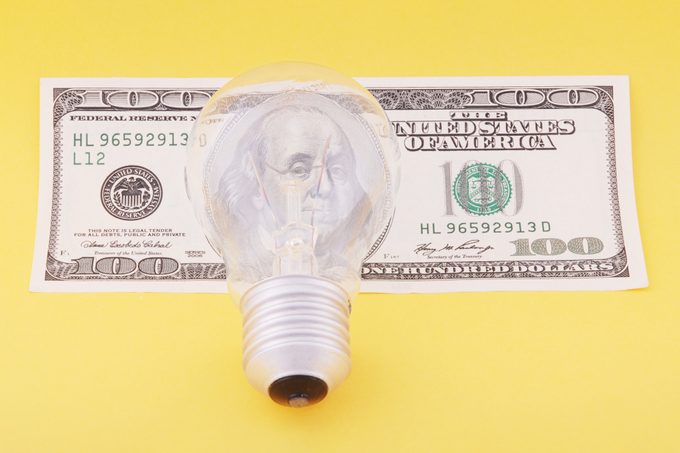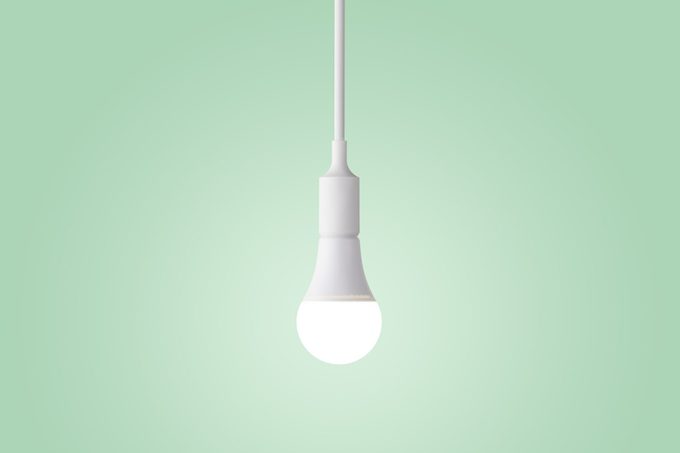33 Smart Ways to Slash Your Home Energy Bills
Updated: Jun. 14, 2023
Feel like the household demands on your hard-earned cash are higher than ever? You're not alone. Luckily, there are steps you can take that add up to noticeable savings.

With news of gas and grocery costs continuing to skyrocket, it’s natural to want to cut spending however you can. Focusing on how to save energy and reduce home energy costs is a smart move, given that the typical U.S. household spends more than $2,000 per year on heating, cooling, powering electronics, lighting, and hot water.
In many ways, practicing sustainable living, water conservation, and other eco-conscious practices like how to save gas not only helps you to be a friend to the environment and reduce your carbon emissions—it also helps your bottom line.
What is energy conservation?
According to experts at Constellation, the largest producer of carbon-free energy in the U.S., energy conservation means deciding to use less energy, then doing whatever it takes to make good on that decision. Turning off lights in empty rooms, unplugging appliances when not in use, and choosing cold water to wash clothes are all good examples of how to save energy and put everyday green living into action.
Why is saving energy important?
Two sit-up-and-take-notice reasons for sustainable living and intentionally conserving natural resources: Using less energy is better for the planet and better for your bank account, because lower energy consumption means lower bills. In other words, conscientious environmental stewardship doesn’t just make for less burning of fossil fuels and a smaller carbon footprint. It can also keep more cash in your wallet. Score one for sustainability!
Summer energy bill

- Limit showers to five minutes by setting a timer and sticking to it.
- Change the filter in your AC regularly for peak efficiency.
- Air-dry linens and towels outdoors in the sun when possible.
- Call your energy supplier to request a free home energy audit. Here’s more on how to save on summer utility bills.
Cooling/HVAC
- If it’s time to replace your HVAC system, the expense is likely a source of dread. Start doing your research early—it’s better to do recon, weigh options, and figure out financing options when you’re not in the midst of a crisis.
- Seek itemized estimates, given in writing, from reputable companies.
- Sometimes paying in cash can help lower the price of a new HVAC, but if you don’t pay cash, beware of higher interest rates when financing.
- To hold the line on your electric bill during the hottest months, set your thermostat to 78 degrees; according to experts, this number is the sweet spot between feeling reasonably comfortable inside and preventing astronomical electricity costs.
- Utilize your ceiling fan to create a “wind-chill effect” in addition to traditional cooling units.
- There’s a lot of information blowing around out there about closing air vents to save energy and make a home more comfortable. However, HVAC experts at Apollo Home, longtime HVAC service providers in the Cincinnati, Ohio, and Northern Kentucky area, strongly advise against this. HVAC systems are designed to heat homes based on their size, and the equipment doesn’t know if you close off air vents. Closing air vents actually forces the system to work harder, which consumes more energy.
Winter energy bill
- There are a wide variety of thermostats available, including programmable models that reduce the guesswork of finding the right temperature for your home, Wi-Fi models you can control with an app, and smart units that self-adjust according to temperature and other factors. Experts say this is the best temperature to keep your home in the winter.
- To save on your heating bill, the usual suggestion is obvious: turn down the thermostat.
- In the winter, reverse the motor of your ceiling fan and operate it at low speed in the clockwise direction to produce a gentle updraft, forcing warm air near the ceiling down into the occupied space. Be sure to adjust the thermostat accordingly.
- If your home relies on oil heat, be sure to get periodic heating system tune-ups to ensure that you benefit from every drop of oil that is burned. According to industry experts, system tune-ups on the regular could reduce costs by up to 10 percent.
- Oil heat pros also point out that a modern burner can cut costs by as much as 15 percent. If you’ve been putting off an upgrade and you’re committed to saving energy, it might be time to reconsider.
Lighting

- It’s certainly worth stating the obvious: One of the easiest ways to save money on electricity is turning off lights when no one is using them.
- Using timers and dimmers can also help better manage usage, as can purchasing three-way bulbs and choosing the lowest wattage that meets your situational needs.
- Light-emitting diodes—LED bulbs for short—are low-heat, energy-efficient, and long-lasting. Experts at Energy Star say that LED products produce light up to 90 percent more efficiently than conventional incandescent bulbs.
- Per Mass Save, a Massachusetts utilities consortium, each incandescent bulb you replace with an Energy Star-certified LED can save you more than $100 over the life of the bulb. They come in a large variety of sizes, shapes, and styles for use indoors and out.
Appliances
- According to experts at EnergySage, a marketplace developed with the U.S. Department of Energy’s Sun-Shot program to help consumers make informed decisions, energy-efficient appliances do require a larger up-front investment than conventional ones. But in most cases, the long-term savings cover more than that spread.
- Appliances generally account for 20 percent of a home’s total electric bill. Energy Star-certified appliances generally use anywhere from 10 to 50 percent less power than regular ones, so over the 10- to 20-year average lifespan of an appliance, those savings can add up.
- To shave even more off your power bills, unplug appliances when not in use. Developing this consistent habit can save $100 to $200 per year. As a bonus, unplugging protects against random power surges that can fry your electronics.
- For maximum operating efficiency, your refrigerator should be set at 40 degrees or lower, and your freezer at 0 degrees.
- If you haven’t replaced your fridge in a while, be aware that current Energy Star models use up to 40 percent less power than conventional refrigerators sold in 2001.
- For maximum energy efficiency, make sure that cold air inside your freezer can circulate freely (meaning the freezer should never be completely jam-packed), and if your model is not self-defrosting, defrost regularly.
- All the popular computer manufacturers you’d expect—Apple, Dell, Lenovo, HP, and others—offer Energy Star-rated desktop computers, laptops, and tablets. They are third-party certified to use 25 to 40 percent less energy than conventional models; for buying guidance on how to save energy by choosing eco-wise computers, learn more here.
- The average American family uses more than 300 gallons of water a day, more than two-thirds of that indoors. The first line of defense against wasting water is to prioritize simple tasks such as fixing leaky faucets and toilets, running only full washing machine and dishwasher loads, and shutting the tap while brushing teeth.
- The U.S. Environmental Protection Agency developed the WaterSense product designation to identify water-efficient faucets, shower heads, toilets, sprinklers, and more. Look for the WaterSense label on retail products.
- Clothes dryers vary widely in how much power they use, depending on age, size, model, and other factors, so it’s hard to pinpoint specific household consumption. However, the average usage is anywhere between 1,500 and 5,000 watts of electricity. Certain things you might do, like overstuff the dryer or forget to clean the lint trap and dryer vent, can push the power draw to the higher side.
- Air-drying clothes is more eco-friendly, but also significantly more time consuming—it’s preferable from a reducing-greenhouse-gases perspective, but it’s only really practical if you have time, space, and favorable weather.
- When it comes to running the dishwasher, the most significant power draw isn’t the electricity, but rather the piping-hot water needed to wash dishes effectively.
- The energy required depends on how much water the dishwasher needs in order to do its job, which depends on when it was manufactured; the older the unit, the higher the number of gallons demanded. Pre-1994 dishwashers used 10 to 15 gallons per load, while the newest Energy Star models need fewer than four gallons. The Direct Energy experts suggest dishwasher users run full loads only and open the door as soon as the cycle ends to let clean items air-dry, instead of depending on the electricity-intensive heat-dry cycle.
- Determining whether taking a bath or shower is cheaper can be tricky because there are many variables: length of shower, preferred water temperature, whether a low-flow shower head has been installed, and more, though research shows that more than half of indoor water use occurs in the bathroom. Experts at Take Care of Texas, a campaign created by the Texas Commission on Environmental Quality to promote environmentalism at home and in the workplace, note that by installing WaterSense-labeled shower heads, the average family can save 2,700 gallons of water each year.
Heat and hot water costs are likely significant line items in any family’s budget. Cutting your cash outlay on these bills is possible, with thoughtful research and attention to detail.
A natural benefit of educating yourself about home-energy usage and associated costs is that you’ll also learn about other actions that can negatively impact the environment, like pollution, greenhouse gases, and climate change more broadly. The resulting bigger-picture thinking may heighten your interest in renewable energy, reducing food waste and consumption, and even sustainable brands. If you end up inspired to replace outmoded, inefficient appliances with new energy-efficient models, be sure to arrange to recycle the old ones properly.
If you want to learn more about reducing waste and shrinking your carbon footprint, check out our article on upcycling here.
Sources:
- Energy Star: “Breaking Down the Typical Utility Bill”
- Constellation: “What Is Energy Conservation?”
- Dor-Mar Heating & Air-Conditioning: “Insider Secrets: How to Save Money When Buying a New HVAC System for Your Home”
- Energy Star: “Ceiling Fan Installation and Usage Tips”
- Oilheat America, National Oil Heat Research Alliance: “Energy Conservation Tips”
- CNET: “Everyone Says to Turn Off Your Lights. But Does That Actually Matter?”
- Energy Star: “Learn About LED Lighting”
- Mass Save: “Energy Saving Tips”
- EnergySage: “What are the most energy efficient appliances and are they worth it?”
- Apollo Home: “Closing Air Vents: Airflow and Energy-Saving Myths Busted”
- U.S. Environmental Protection Agency: “How We Use Water”
- U.S. Environmental Protection Agency: “WaterSense Products”
- Direct Energy: “How Much Electricity Does My Dishwasher Use?”
- Take Care of Texas: “The Shower vs. Bath Debate”



